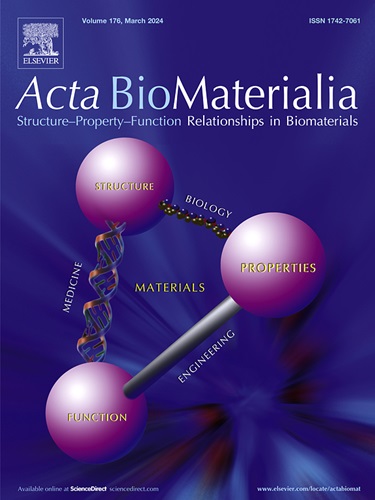Mechanistic insights into hydration-driven shape memory response in keratinous avian feather structures
IF 9.4
1区 医学
Q1 ENGINEERING, BIOMEDICAL
引用次数: 0
Abstract
Keratinous materials found in the feather shafts of flying birds possess impressive mechanical attributes, combining excellent strength-to-weight balance, toughness, and more. In this study, we investigate the shape memory effect in bird feather shafts, examining its underlying design principles as templates for bioinspired shape memory composites. Through analytical and computational analysis, we aim to uncover the underlying rules and design guidelines based on stimulus-induced softening (pertaining to strength and/or stiffness) and swelling (pertaining to expansion in volume). More specifically, we study a one-dimensional case to examine the synergistic relationship between the matrix and fibers inside the feather structure. We propose three distinct micro-mechanical modeling approaches to evaluate the contribution of each hydration-induced effect—softening, swelling, and the combined action of both. In all models, the matrix is considered to be an elastic-perfectly plastic material that is sensitive to hydration, while the fibers are treated as purely elastic and unaffected by hydration. The findings of the study provide informative insights into the nuanced nature of swelling within the material, highlighting that its desirability is dependent on specific conditions and circumstances. Furthermore, we find that the softening component plays a large pivotal role in driving the process of shape recovery. Using the proposed analytical framework and design principles, we develop a conceptual feather shaft-like composite, followed by demonstrating its tunability in degree of shape recovery and its versatility in selecting constituent base material components. This research offers valuable core framework for exploring and designing advanced bioinspired shape memory materials while eliminating the need for traditionally active shape memory components, holding promising potential for actuation, deployment, and morphing purposes.
Statement of significance
This study investigates the shape-memory effect in bird feather shafts, offering bioinspired strategies for designing advanced shape-memory composites. Unlike conventional materials, which often rely on external stimuli or active components, our research focuses on hydration-driven mechanisms–specifically, matrix softening and swelling. Through micro-mechanical modeling, we demonstrate that softening is the key driver of shape recovery, while swelling plays a secondary role under specific conditions. These insights provide new, passive design principles for creating tunable shape-memory composites without the need for traditional active components. The findings have broad implications for applications in actuation, morphing, and reconfigurable systems, where material adaptability is crucial.

求助全文
约1分钟内获得全文
求助全文
来源期刊

Acta Biomaterialia
工程技术-材料科学:生物材料
CiteScore
16.80
自引率
3.10%
发文量
776
审稿时长
30 days
期刊介绍:
Acta Biomaterialia is a monthly peer-reviewed scientific journal published by Elsevier. The journal was established in January 2005. The editor-in-chief is W.R. Wagner (University of Pittsburgh). The journal covers research in biomaterials science, including the interrelationship of biomaterial structure and function from macroscale to nanoscale. Topical coverage includes biomedical and biocompatible materials.
 求助内容:
求助内容: 应助结果提醒方式:
应助结果提醒方式:


